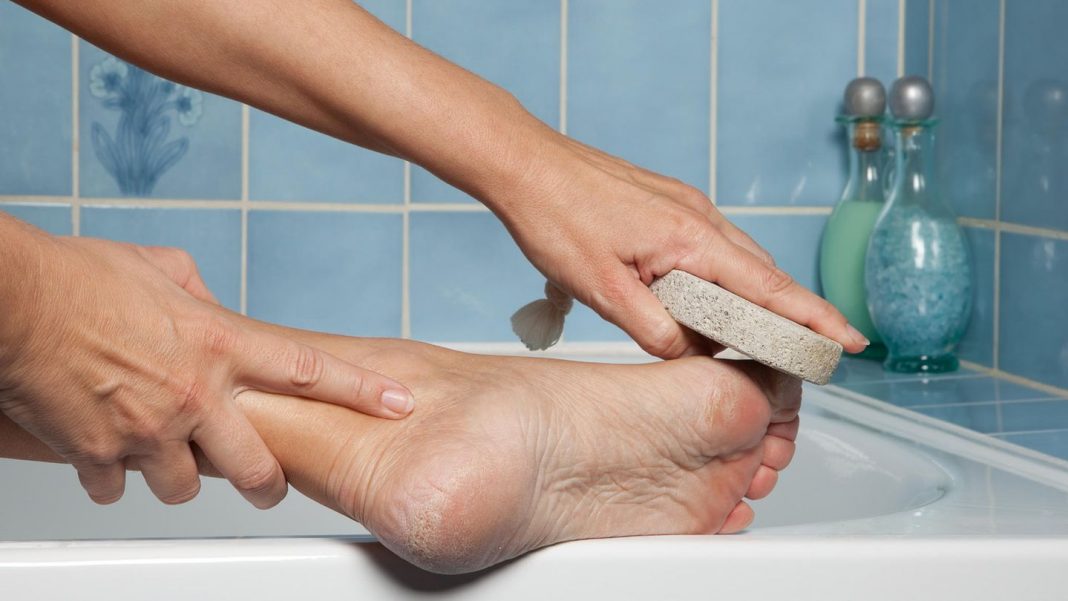Cracked heels
Remove the cornea: your feet (again) become soft and supple

The pumice stone is a proven means of removing cornea on the feet
© Studio-Annika / Getty Images
Calluses on heels and bales usually serve to protect the feet – but if it becomes too thick, it can tear. This not only looks ugly, but also causes pain. Here you will learn how to remove and prevent calluses.
Thickened cornea is favored by external influences, such as too much pressure and friction from tight or uncomfortable shoes. But also dust, heat and sweat promote cornea by drying the skin. This can be seen especially well on the heels and bales in the hot summer months, when most people wear thin shoes such as sandals or flip-flops. However, if the cornified areas tear, bacteria have an easy time-they penetrate the skin and trigger painful inflammation. It is all the more important to regularly care for the calluses, cornified areas and cracked heels by removing the Remove cornea. How this works best is summarized below.
Removing the cornea step by step: how to do it
1. Start with a foot bath
In order for you to remove the excess cornea, you must first soak it-with a Foot bath. To do this, use lukewarm water, in which you add either 100 milliliters of apple cider vinegar, a little tea tree oil or Dead Sea salt. On the one hand, your feet are cleaned in this way, on the other hand, in particular Salt germicidal. Place your feet in ankle-deep water and let the foot bath act for ten to a maximum of 15 minutes.
2. Use a pumice stone
To remove the excess skin will help different tools. A classic is the Pumice, which was already used in ancient times for foot care. Unlike a planer or rasp, the coarse-pored volcanic rock only removes the upper layers of the skin, so there is no risk that you remove too much cornea and your feet are thus defenseless. Alternatively, you can also use a Corneal file use.
3. Cream your feet
After the treatment, it is important to take care of the abraded skin. For this, it is best to take a Creamwhich provides your feet with sufficient moisture and at the same time helps to prevent new calluses from forming so quickly. Alternatively, you can also use so-called Foot butter which is quickly absorbed into the skin and leaves a smooth, supple feeling.
New beauty trend: foot mask instead of pedicure
In order to save time and money, more and more people are abandoning professional pedicures – and are instead focusing on a new beauty trend: so-called Foot Masks. This is a kind of sock that you just have to put over your feet. The special feature of the foot masks is that they contain a nourishing moisturizing emulsion (including milk, aloe VVera and papain) that penetrates and softens your skin. Depending on how much cornea you have, your feet can even “peel”, that is, the old layers of skin are repelled – and under them new, soft skin appears.
Important: If you have particularly sensitive skin, you should test whether you are allergic to the foot mask before use. To check, dab some liquid from the mask on your skin and wait ten minutes.
The best home remedies for cornea
Of course, there are also popular home remedies that allow you to remove cornea. These include:
-
Mix three teaspoons Baking soda with lukewarm water and soak your feet in it for ten minutes. Alternatively, you can use baking soda and a little water to make a kind of paste that you rub your feet with and leave on for five minutes – before washing your feet and rubbing them off.
-
Dried Camomile is also an effective home remedy for cornea. To do this, either take a tea bag or loose chamomile flowers that you wrap in a dry cloth, drizzle them with hot water so that they are wet – but not dripping – and press the chamomile bag on the cornified areas for 15 minutes.
-
Another beauty secret weapon is fresher Lemon – a home remedy that is always used when it comes to skin problems. This is due to their acidity, which can also help against cornea. To do this, cut one lemon in half and place the halves on the cornified areas for a maximum of 30 minutes.
How to prevent calluses
So that the skin on your heels and bales does not dry out and keratinize in the first place, you can take preventive measures:
- Do not wear shoes that are too tight or uncomfortable – as a result of pressure, cornea is formed faster to protect the feet from friction.
- It is best to change your shoes regularly as often as possible, so that the same places are not always irritated.
- In addition, if possible, refrain from high heels and too thin or too hard soles. Instead, run barefoot as often as possible.
- Give your feet a bath regularly and then always cream the skin with an ointment containing urea or salicylic acid.
You may also be interested in:
This article contains so-called affiliate links. More information can be found here.


